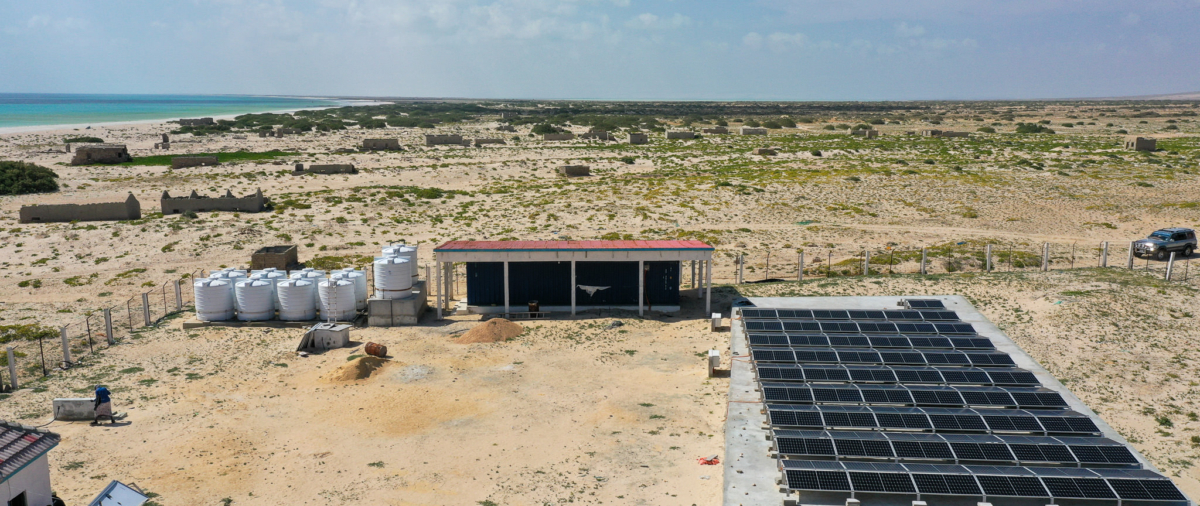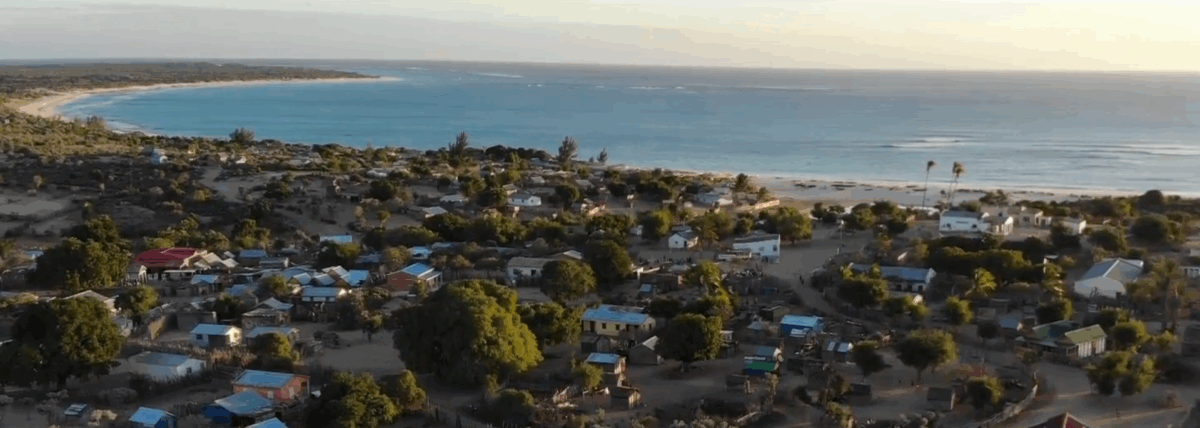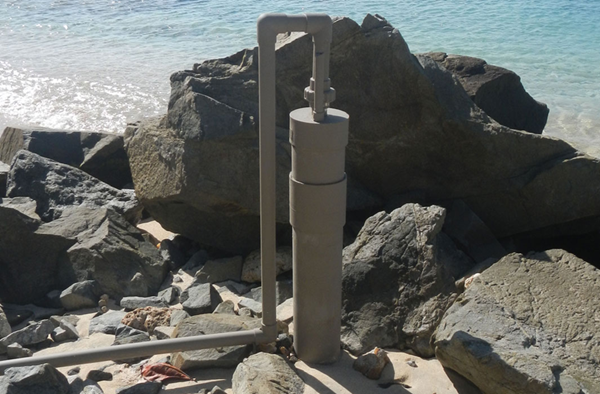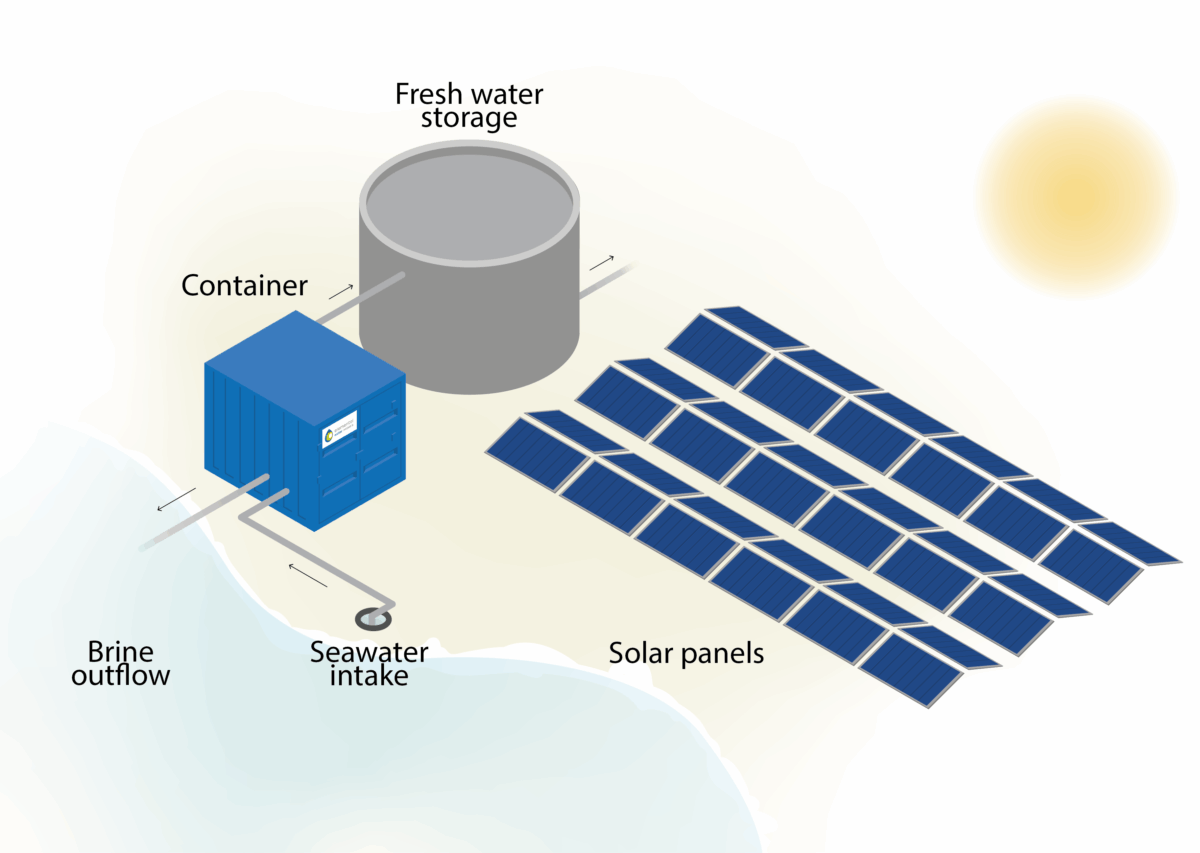The best locations for solar desalination plants combine abundant sunshine (at least 5-6 hours daily), proximity to seawater, minimal grid infrastructure, and areas facing water scarcity. Coastal regions with high solar radiation, stable weather patterns, and limited freshwater resources make ideal candidates. These locations typically receive 250-300 sunny days annually and sit within 500 metres of the coastline, creating perfect conditions for sustainable water production.

An aerial view of a solar desalination plant located in Somalia
What factors determine the best location for solar desalination? #
When you’re looking for the perfect spot for solar desalination, four main factors come into play. First, you need consistent solar radiation – at least 5-6 hours of direct sunlight daily throughout the year. Second, proximity to clean seawater is essential, ideally within 500 metres of the coast to minimise pumping costs and energy requirements.
Third, the location should have minimal existing grid infrastructure or face high electricity costs, making solar power the most practical option. Finally, areas experiencing water scarcity or paying high prices for freshwater (often €5-10 per cubic metre) benefit most from this technology. The combination of these factors creates an environment where solar desalination becomes not just viable, but the most sensible solution.
Climate stability also plays a role. Locations with predictable weather patterns and minimal extreme events allow for consistent operation throughout the year. This reliability is particularly important for resorts and private properties that depend on steady water supply for their guests and operations.
Why do tropical and subtropical coastal areas work best for solar desalination? #
Tropical and subtropical regions offer the most favourable conditions for solar desalination because they receive consistent solar radiation year-round, typically enjoying 250-300 sunny days annually. These areas, located between 35°N and 35°S latitude, experience minimal seasonal variation, which means your system can operate at peak efficiency throughout the year.
The temperature benefits in these regions go beyond just sunshine. Warmer ambient temperatures improve the efficiency of the desalination process itself, as seawater requires less energy to process when it’s already warm. Additionally, these locations rarely experience freezing conditions that could damage equipment or interrupt operations.
The stable weather patterns in tropical and subtropical zones mean you can count on predictable solar resources. Unlike temperate regions where winter months might see dramatic reductions in solar availability, these areas maintain relatively consistent daylight hours and sun intensity. This consistency translates directly into reliable water production, making it easier to plan and manage your water resources effectively.
How does proximity to the ocean affect solar desalination plant placement? #
Being within 500 metres of the coastline is ideal for cost-effective seawater intake, as every additional metre of pipeline increases both installation costs and ongoing pumping energy requirements. When you place your desalination system close to the ocean, you minimise these expenses while maximising operational efficiency.
The choice between beach well systems and direct ocean intake depends on your specific location. Beach wells offer natural filtration through sand and gravel, reducing pre-treatment requirements and protecting against marine life intrusion. However, they require suitable geological conditions. Direct ocean intake systems work in more locations but need additional filtration and screening equipment.
Environmental considerations also influence placement decisions. You’ll want to avoid areas with heavy boat traffic, industrial discharge, or natural phenomena like red tide blooms. Protected bays and coves often provide the best balance, offering calmer waters for intake structures while maintaining good water circulation to ensure quality. The distance from shore also affects the salinity and temperature of your source water, both of which impact system efficiency.
What role does local water scarcity play in choosing desalination sites? #
Areas with limited freshwater resources, high water costs, or unreliable municipal supply benefit most from solar desalination. When traditional water sources cost €5-10 per cubic metre or require expensive trucking, solar desalination becomes an attractive alternative that can pay for itself through operational savings.
Island communities face unique challenges that make them prime candidates for this technology. Many islands rely on rainwater collection, which becomes unreliable during dry seasons, or expensive water shipments from the mainland. Remote coastal resorts often find themselves in similar situations, where connecting to municipal water systems would require prohibitively expensive infrastructure development.
The reliability factor cannot be overstated. In locations where water supply interruptions are common, having an independent water source powered by the sun provides peace of mind and operational continuity. This is particularly valuable for hospitality businesses where guest satisfaction depends on consistent water availability. Properties in areas prone to drought or with depleting groundwater resources find solar desalination offers a sustainable long-term solution.
Which environmental conditions should you avoid when selecting a location? #
Certain environmental conditions can significantly impact the performance and longevity of solar desalination systems. Areas prone to hurricanes or severe storms pose risks to both solar panels and intake structures, requiring additional protective measures that increase costs. While systems can be designed to withstand these conditions, locations with more stable weather patterns offer better long-term reliability.
Excessive marine growth, high sediment loads, and extreme tidal variations create operational challenges that increase maintenance requirements. Waters with heavy algae blooms or frequent red tide events can clog intake systems and reduce water quality, requiring more intensive pre-treatment. Similarly, locations near river mouths often experience variable salinity levels and higher sediment content, making consistent operation more difficult.
Protected bays and stable shorelines provide optimal operating conditions. These areas typically have:
- Minimal wave action that could damage intake structures
- Consistent water quality throughout the year
- Natural protection from extreme weather events
- Lower levels of marine growth and sediment
The key is finding a balance between protection and water circulation. Completely enclosed areas might offer protection but could suffer from poor water quality, while exposed coastlines might have excellent water quality but face operational challenges during rough weather.
How can Elemental Water Makers help you find the perfect desalination location? #
Finding the perfect location for your solar desalination system requires evaluating multiple factors simultaneously. We bring experience from over 100 installations across 35 countries, helping you assess your specific site conditions for optimal system performance. Our team evaluates solar resources, water quality, environmental conditions, and local regulations to determine the best approach for your property.
Our plug-and-play solar desalination systems are designed for locations with limited grid access, while our efficient desalination solutions work perfectly for properties with existing electrical infrastructure. Both options deliver water that meets WHO drinking water standards while using only 3 kWh/m³ of fresh water produced, achieving up to 70% energy savings compared to conventional methods.
We understand that each location presents unique challenges and opportunities. Whether you’re managing a remote island resort or a coastal villa, we help you navigate site assessment, system sizing, and permit applications. We can help in submitting the technical data that may be required to apply for the permits locally. Our modular systems adapt to your specific needs, with capacities ranging from 5,000 to 100,000 litres daily, ensuring you have the right solution for your water requirements.
Frequently Asked Questions #
How much does it cost to install a solar desalination system in an ideal location?
Installation costs vary significantly based on capacity and site conditions. A small solar desalination solution (5 m³/day) costs around €70,000 for investment including equipment, transport and installation, while a large system (100 m³/day) costs around €450,000. For efficient desalination systems, costs range from €40,000 for small systems (11 m³/day) to €190,000 for large systems (88 m³/day). After 15 years including operational costs, water rates range from 1-3 €/m³ depending on system size. Locations with current water costs of €5-10 per cubic metre often see attractive payback periods through operational savings.
What maintenance is required for solar desalination systems in coastal environments?
Regular maintenance includes cleaning solar panels monthly (more frequently in dusty areas), checking and cleaning pre-filters weekly, and performing membrane cleaning or replacement every 3-5 years depending on water quality. Coastal environments require additional attention to corrosion prevention, with quarterly inspections of metal components and annual anti-corrosion treatments. Most systems need only 2-4 hours of maintenance per week, making them practical for remote locations.
Can solar desalination work effectively during cloudy periods or monsoon seasons?
Modern solar desalination systems incorporate battery storage or hybrid configurations to maintain operation during cloudy periods, typically providing 1-3 days of autonomous operation. During extended cloudy periods like monsoon seasons, systems can operate at reduced capacity (30-50%) or integrate with backup power sources. Many tropical locations still receive 3-4 hours of usable sunlight even during rainy seasons, allowing for partial water production.
What permits and environmental assessments are typically required for coastal installations?
Most coastal installations require environmental impact assessments focusing on brine discharge effects, marine life protection measures, and coastal zone management compliance. Common permits include water extraction licenses, coastal development permits, and environmental discharge authorizations. The permitting process typically takes 3-6 months and may require demonstrating minimal impact on local marine ecosystems through proper brine dilution and discharge strategies.
How do you determine the right system size for a specific location and application?
System sizing depends on daily water consumption (typically 200-300 litres per person for resorts), peak demand periods, and storage capacity. Calculate your maximum daily requirement, add a 20-30% safety margin, and consider seasonal variations in both demand and solar availability. For resorts, factor in pool filling, irrigation, and peak occupancy periods. Professional assessment tools can model your specific location's solar resources against water demand patterns to optimize system size.
What are the most common mistakes when selecting a location for solar desalination?
The most common mistakes include underestimating the importance of water quality testing before installation, choosing locations with insufficient wave protection leading to intake damage, and failing to account for future coastal development that might affect water quality. Other frequent errors include inadequate consideration of seasonal variations in solar resources, placing systems too far from the point of use increasing distribution costs, and neglecting local regulations regarding brine discharge zones.




